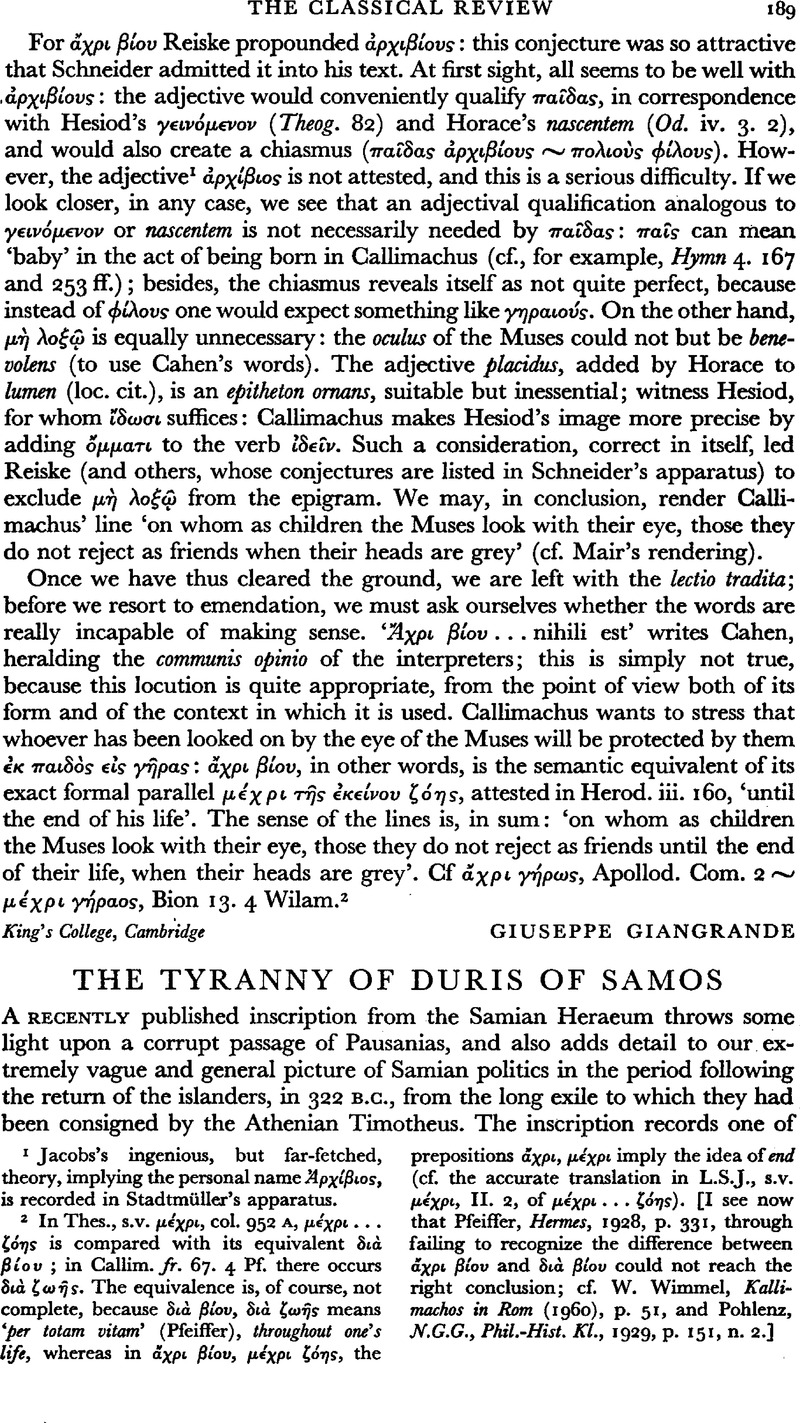Article contents
The Tyranny of Duris of Samos
Published online by Cambridge University Press: 27 February 2009
Abstract

- Type
- Review Article
- Information
- Copyright
- Copyright © The Classical Association 1962
References
page 189 note 1 Jacobs's ingenious, but far-fetched, theory, implying the personal name Ἀρχ⋯βιος, is recorded in Stadtmüller's apparatus.
page 189 note 2 In Thes., s.v. μ⋯χρι col 952 A, μ⋯χρι … ζ⋯ης is compared with its equivalent δι⋯β⋯ου; in Callim. fr. 67. 4 Pf. there occurs δι⋯ ζω⋯ς The equivalence is, of course, not complete, because δι⋯ β⋯ου, δι⋯ ζω⋯ς means ‘per totam vitam’ (Pfeiffer), throughout one's life, whereas in ἄχρι β⋯ου, μ⋯χρι ζ⋯ης the prepositions ἄχρι, μ⋯χρι imply the idea of end (cf. the accurate translation in L.S.J., s.v. μ⋯χρι II. 2, of μ⋯χρι … ζ⋯ης). [I see now that Pfeiffer, , Hermes, 1928, p. 331Google Scholar, through failing to recognize the difference between ἄχρι β⋯ου and δι⋯ β⋯ου could not reach the right conclusion; cf. Wimmel, W., Kallimachos in Rom (1960), p. 51Google Scholar, and Pohlenz, , N.G.G., Phil.-Hist. Kl., 1929, p. 151, n. 2.Google Scholar]
page 190 note 1 Habicht, C., ‘Samische Volksbeschlüsse der hellenistischen Zeit’, Ath. Mitt. Ixxii (1957), 152 ff.Google Scholar: no. 23, pp. 190 ff. For earlier publication of others of the series, see Schede, M., ‘Aus dem Heraion von Samos’, Ath. Mitt. xliv (1919), 1 ff.Google Scholar; S.E.G. i, nos. 350 ff. I am most grateful to Professor A. Andrewes and Mr. Russell Meiggs for reading ajid discussing drafts of this paper.
page 190 note 2 The manuscripts here give a subject, Χ⋯ονιν. This is obviously corrupt, for the name is that of the Spartan whose stele Paus. has just recorded, standing next to Kaios' statue. Some editors have restored Καῖον, for clearly he is meant. More plausibly, Schwartz merely removed Χ⋯ονιν as a gloss, added precisely because there was no name in the original text.
page 191 note 1 For the form of the sentence cf. vi. 19. 3, ad init.; and for this placing of the name, following quotation of an inscription about the same man, cf. v. 25. 13.
page 191 note 2 Not in Kirchner, Prosop. Att. Pape–Benseler, Wörterbuch der gr. Eigennamen, record it as equivalent to Roman Caius: (1) C.I.G. 4036, set up at Ancyra by K. Αἴλιος Ἀγησ⋯λαος—but this is surely Κ(οῑ́ντος), following universal practice; (2) Mionnet, , Descr. des Médailles, suppl. vii (Paris, 1835), 559, no. 336Google Scholar, a coin of Aezanis of the late second or early first century B.C., inscribed ΕΓΙΚΤΗΤΕΩΝ and ΚΑΙΟΥ. There is a similar piece in B.M.C. Phrygia, p. 208, no. 8, pl. xxvi. 4, inscribed ΕΓΙΚΤΗΤ and ΓΑΙΟΥ. This is the regular hellenized form, and Mionnet's reading of ΚΑΙΟΥ, if not mistaken, appears unique.
page 191 note 3 During the exile: Paus. loc. cit. For the dates, see Beloch, , Griech. Gesch. iii. 22. 245 f.Google Scholar
page 191 note 4 For the years from 17 to 20 as the age of eligibility, cf. Gardiner, E. N., Athletics in the Ancient World (Oxford, 1930), 41Google Scholar, where this rule is deduced for Olympia from the practice of the Neapolitan Augustalia, a festival on the Olympic model (Olymp. Inschr., no. 50). The absence of birth certificates allowed a small margin of latitude: cf. the story of the Samian κομ⋯της victorious in 588 B.C., Eratosthenes ap. Diog. Laert. viii. 47–48 (F. Gr. Hist. 241 F 11).
page 191 note 5 It may be that we can extend the stemma upwards. Duris claimed to be an ⋯π⋯γονος of Alcibiades (T 3: Plut. Alc. 32). Jacoby (II C, p. 116) follows most writers in rejecting the claim as an easy one to make falsely. Its falsity is not, of course, demonstrated thereby.
- 5
- Cited by


